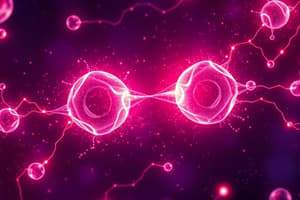Podcast
Questions and Answers
What is the relationship between bond strength and bond length?
What is the relationship between bond strength and bond length?
- There is a direct correlation between bond strength and bond length.
- Bond strength and bond length are independent of each other.
- Shorter bonds always have lower energy than longer bonds.
- Bond strength is inversely correlated with bond length. (correct)
What occurs when two atoms with different electronegativities form a bond?
What occurs when two atoms with different electronegativities form a bond?
- The atom with lower electronegativity receives a partial negative charge.
- Lone pairs of electrons will participate in bonding.
- The atom with higher electronegativity will attract the bonding electrons towards itself. (correct)
- The bond always becomes a non-polar bond.
What defines a single covalent bond between two atoms?
What defines a single covalent bond between two atoms?
- Formation of a triple bond.
- Attraction between two opposite charges.
- Presence of lone pairs in the bonding region.
- Sharing of one electron pair. (correct)
Which bond exhibits the highest bond energy according to the provided data?
Which bond exhibits the highest bond energy according to the provided data?
What are lone pairs of electrons?
What are lone pairs of electrons?
What characterizes an ionic bond?
What characterizes an ionic bond?
Which statement is TRUE regarding ionic compounds?
Which statement is TRUE regarding ionic compounds?
What determines the lattice energy of an ionic compound?
What determines the lattice energy of an ionic compound?
What property of metallic bonding contributes to the malleability of metals?
What property of metallic bonding contributes to the malleability of metals?
Which type of bonding typically results from an electronegativity difference greater than 2?
Which type of bonding typically results from an electronegativity difference greater than 2?
What is the primary reason ionic compounds conduct electricity in solution?
What is the primary reason ionic compounds conduct electricity in solution?
Which of the following ionic compounds has the highest lattice energy?
Which of the following ionic compounds has the highest lattice energy?
What is the main characteristic of a metallic bond?
What is the main characteristic of a metallic bond?
Flashcards are hidden until you start studying
Study Notes
Chemical Bonding
- A chemical bond is an electrostatic force that holds atoms together in a compound.
- When atoms are closer together, the system has lower energy, indicating bond formation.
- There are three types of chemical bonds: ionic, metallic, and covalent.
Ionic Bonding
- Ionic compounds form a 3D lattice structure, influenced by ion radii and stoichiometry.
- Electrons are transferred to form cations (positively charged) and anions (negatively charged).
- Ionic bonds arise from electrostatic attraction between oppositely charged ions.
- The strength of attraction depends on ion size and charge (charge density).
- Ionic interactions are isotropic meaning they are non-directional.
- Electronegativity differences greater than 2 generally lead to ionic bonds.
- Compounds formed between Group 1 and 2 with Group 16 and 17 elements are typically ionic.
- Lattice energy measures the strength of ionic attraction and influences properties such as melting point, hardness, and solubility.
- Lattice energy is the energy required to separate one mole of ionic solid into gaseous ions.
- For example, NaCl(s) → Na+(g) + Cl–(g) LE = +788 kJ mol-1
- For example, Na2O(s) → 2Na+(g) + O2–(g) LE = +2488 kJ mol-1
- For example, MgO(s) → Mg2+(g) + O2–(g) LE = +3800 kJ mol-1
- Ionic compounds typically exhibit the following properties:
- They exist as hard, crystalline, and brittle solids.
- They have high melting points.
- They do not conduct electricity in solid form.
- They conduct electricity when molten or in solution (for soluble compounds) as ions are released to carry the current.
Metallic Bonding
- Elements with low ionization energies often have mobile valence electrons, creating a "sea of electrons" and metallic bonding.
- For example: Fe(s)
- Metals typically show the following properties:
- Good electrical conductivity in both solid and molten states due to mobile electrons.
- Malleable and ductile (atoms can slide across each other in the electron sea).
- Variable, but often low melting points due to the relatively weak attraction between nuclei and mobile electrons.
- High boiling points as the attraction between nuclei and mobile electrons must be overcome.
Covalent Bonding
-
In covalent bonds, electrons are shared between two atoms.
-
The bond length is the specific distance between the bonding nuclei where the molecule's energy is minimized.
-
A single covalent bond involves a pair of shared electrons.
-
Some atoms can share more than one electron pair, leading to double bonds (two shared pairs) or triple bonds (three shared pairs).
-
Lone pairs or non-bonding pairs of electrons refer to pairs of electrons in the valence shell that are not involved in bonding.
-
Polar covalent bonds form when electrons are shared unequally between two different atoms due to electronegativity differences.
-
The atom with higher electronegativity (EN) attracts the electron pair, resulting in a partial negative charge, while the other atom has a partial positive charge.
-
An indirect correlation exists between bond strength and bond length: stronger bonds are generally shorter.
Bond Energy Bond length (kJ mol-1) (pm) H-H 432 74 C-H 413 109 Cl-Cl 239 199 Br-Br 193 228 C-C 347 154 C=C 614 134 C≡C 839 121
Studying That Suits You
Use AI to generate personalized quizzes and flashcards to suit your learning preferences.




